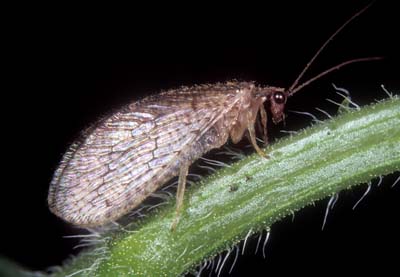
Adult brown lacewing, Hemerobius sp.
(Photographer: James Castner, University of Florida)
These lacewings are small to medium in size (0.3 cm to 0.9 cm) and both males and females of the same species are similar in appearance. These lacewings resemble green lacewings but are brownish in color, and their wings are more curved over their abdomens. The white eggs are laid on plants, but are not stalked (as are green lacewing eggs),. The larvae are similar to lady beetles, but have large jaws and long bodies and do not collect trash on their bodies as do some green lacewing species. Brown lacewings are less common than green lacewings.
The life cycle of brown lacewings requires between 37 to 60 days. Adult female brown lacewings begin to lay eggs after a three to seven day preoviposition period. Females deposit from 100 to 460 eggs. There are one to five generations of brown lacewings per year.
These insects are usually found in wooded areas throughout the United States.
Brown lacewings prey on aphids, mealybugs, insect eggs, other soft-bodied insects, and are also cannibalistic.
Images
To save the Web-optimized images shown below to your hard drive:
|
Click to access Display and Print quality images. |
|
Click to access Display and Print quality images. |
|
Click to access Display and Print quality images. |